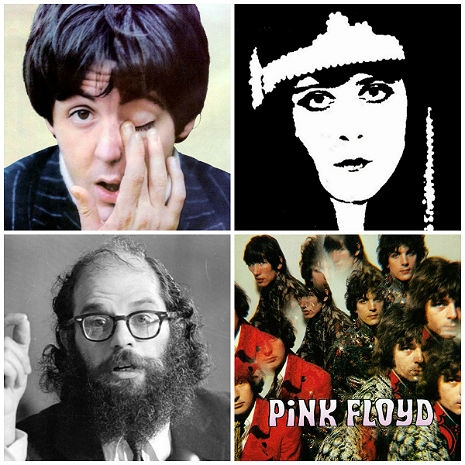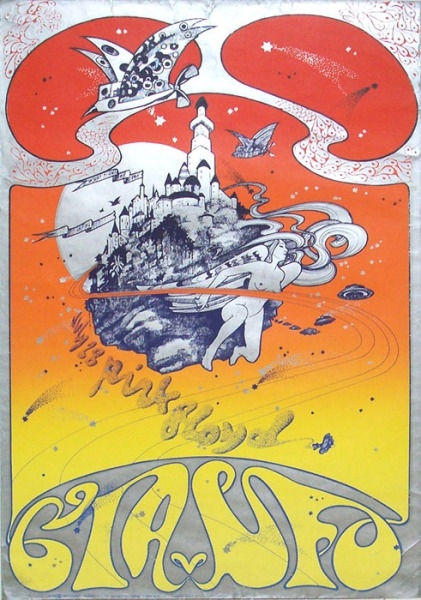
The short-lived UFO Club was a small, pioneering psychedelic club in London that operated from December 1966 to October 1967. It was born as a result of the underground newspaper The International Times’ fabulously successful launch party at the Roundhouse on October 14, 1966, where the early Pink Floyd and Soft Machine performed. IT‘s visionary owners Joe Boyd and John “Hoppy” Hopkins opened the UFO Club in a basement at 31 Tottenham Court Road under Gala Berkeley Cinema on December 23, 1966. The club was open every week “10:30 until dawn.” A one-year membership was 15 shillings but “Overseas visitors need not be members” (according to a UFO Club ad for a Procol Harum show). Mick Farren was a doorman.
The roster of artists who played there is mind-blowing: Barrett-era Pink Floyd (the house band), The Move, The Pretty Things, Graham Bond, The Crazy World of Arthur Brown, Soft Machine, Denny Laine, Fairport Convention, and Jimi Hendrix, Eric Burdon and The New Animals, Dantalion’s Chariot (with Zoot Money and future Police guitarist Andy Summers), The Bonzo Dog Band, The Smoke, Third Ear Band, Jeff Beck, Ten Years After, and (Giant) Sun Trolley.
Movies were shown (Buñuel, Dali, W.C. Fields, Marilyn Monroe, Kenneth Anger), first-generation light shows and film projections (by Mark Boyle and Joan Hills), and vegetarian macrobiotic food was served. LSD was easy to find.
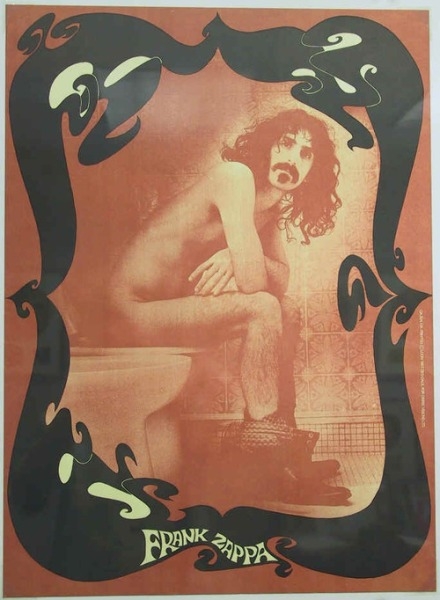
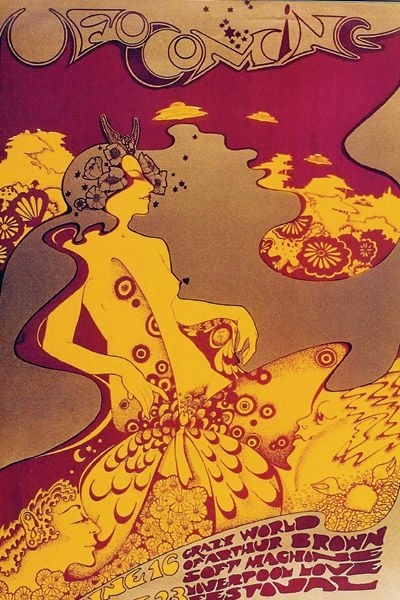
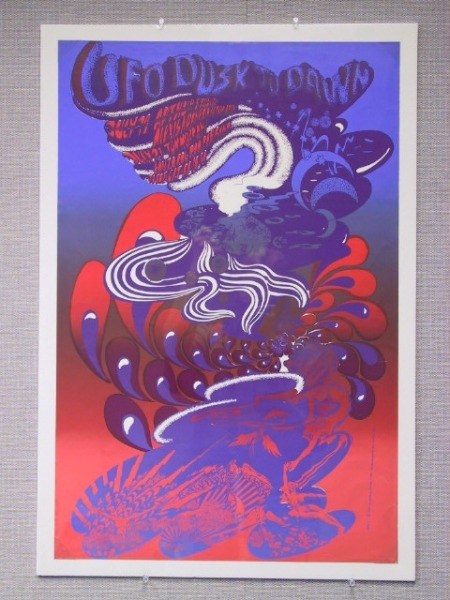
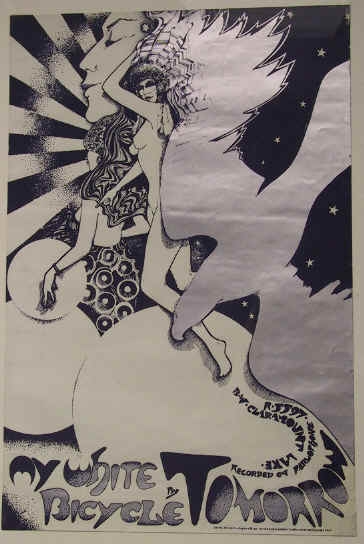

Andy Summers wrote in his autobiography One Train Later:
In the Roundhouse, the UFO, and the Middle Earth Club in London everyone seems to get it, and it’s as if we are all in on the same joke. Our music expresses the release, the dropping of old conventions, the newly found freedom – and to play old-style R&B in these places would be distinctly uncool.
UFO Club owners Joe Boyd and Hopkins were inspired by American music venues’ colorful commissioned concert posters and decided to follow suit. They chose pop artists Michael English and Nigel Waymouth, a.k.a. Hapshash & the Coloured Coat, to design promotional posters for the UFO Club. English had already worked on the first few issues of IT.
The two men met in 1966 when both were involved in creating exterior murals for trendy London clothing shops, English at Hung On You, and Waymouth at his own boutique Granny Takes A Trip, on Kings Road. Granny Takes A Trip, opened by Waymouth and artists John Pearse and Sheila Cohen, was the hippest clothing store, selling antique clothes and original psychedelic designs to hippies, young aristocrats, and rock stars and their consorts (Mick Jagger, Brian Jones, Ronnie Wood, Rod Stewart, Andy Summers, The GTO’s Miss Pamela, Marianne Faithfull, and Anita Pallenberg). In 1967 English and Waymouth formed their graphic design partnership, Hapshash and the Coloured Coat (earlier discarded names were Cosmic Colors and Jacob and the Coloured Coat).
Hapshash’s intricate, detailed, sometimes illegible posters were printed by IT offshoot Osiris Visions in the Indica Gallery (owned by Marianne Faithfull’s husband John Dunbar, Peter Asher, and IT editor Barry Miles and heavily invested in by Paul McCartney), located in the basement of the Indica Bookshop. The Creative Review said in 2011 before a Hapshash retrospective at London’s Idea Generation Gallery: “Many of the posters were designed to be largely illegible to those not prepared to stand and read them – thus the artists could get away with including explicit elements, subversive codes and messages.”
The Houston Freeburg Collection website quoted Nigel Waymouth’s description of his collaboration with Michael English:
Michael’s talent lies in his ability to balance an unrivaled attention to detail whilst creating the most fluid designs. I brought to the work a strong imagination bursting with romantic ideas and a facility for figurative drawing. We also had a very strong sense of colour, which was important , given the cost limitations and the strictures of the silk screen process. At a time when the prevailing fashion was for an indiscriminate use of rainbows and any clashing colour combination, we strived for maximum colour effect without sacrificing balance or harmony. To this end we introduced numerous innovations that have since become common practice. Expensive gold and silver inks had not been used much on street posters before we made it a regular feature of our designs. We also pioneered the technique of gradating from one colour to another on a single separation. The effects were startling, bringing an explosive vitality to the fly posters on the London streets. Nothing like it had been seen before or since. Looking at a whole block of some twenty or thirty of a single Hapshash poster was a powerful visual shock. It was not long before people began tearing some of them down in order to decorate their own walls. It was eye candy to match any psychedelic experience. In hindsight we now realize that what we had done was to bridge a gap between Pop Art and tagged graffiti. The posters often contained subversive elements, including sexually explicit graphics, mystical symbols and dissenting messages. We regarded each poster, whatever it was promoting, not only as an aesthetically pleasing design but also as a proactive concept. We got away with it because the posters were so charming to look at and the contents, including the words, required closer attention than people could give them at first glance. Our immediate audience was the younger generation, sympathetic to the spirit of the times but we also wanted to brighten the lives of people going about there everyday business on the gray streets of London.
For eighteen months Hapshash also did similar artwork for album covers (The Incredible String Band), the sleeve for The Who’s single “I Can See For Miles,” the film Luv Me, promotional posters for Tomorrow, Soft Machine, Jimi Hendrix Experience, The Who, Traffic, Granny Takes a Trip, the 1968 International Pop Festival in Rome, the Middle Earth Club, the Savile Theatre, and the the 14-Hour Technicolour Dream “free speech benefit” fundraiser at Alexandra Palace on April 29, 1967 to help IT with legal fees. The posters’ screen-prints were often given away to members of the audience at the end of a night (well, very early morning). An illicit cottage industry has grown up around bootlegging these posters and inventing unlikely stories about their origins. There is a good checklist of how to spot fakes here.
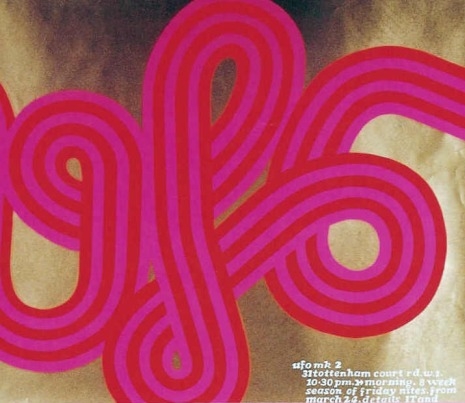

More posters + Soft Machine at the UFO Club, June 2, 1967 after the jump…
Posted by Kimberly J. Bright
|
09.06.2013
01:18 pm
|
